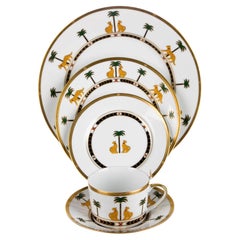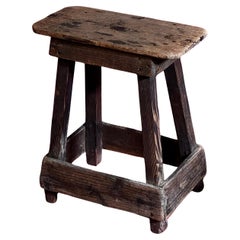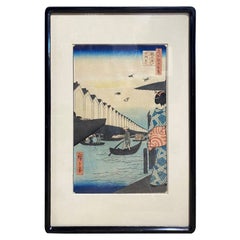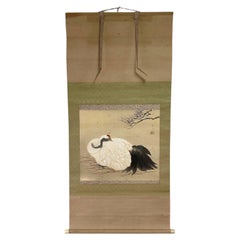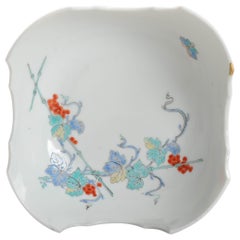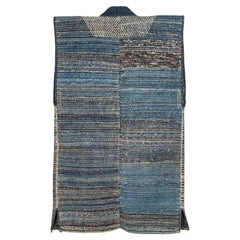Japanese Furniture
to
1,908
4,789
3,344
9,332
924
175
663
332
90
68
48
37
31
24
24
14
10
6
4
3
3
2
1
610
3,438
5,284
1,099
1,656
1,629
945
183
52
139
104
80
282
396
287
271
103
3,461
3,363
2,497
2,300
1,463
14,018
569,451
173,961
165,598
138,016
10,431
10,265
10,308
91
42
41
40
38
Place of Origin: Japanese
Christian Dior Casablanca Dinnerware Set ~ 8 Place Settings / 40 pieces
By Christian Dior
Located in New York, NY
A set of 8 (eight) place settings (40 total pieces) in the signature Casablanca pattern by Christian Dior.
Features a white, gold and multicolor pattern with panther and palm tree motifs throughout, gilt accents throughout and brand stamp at undersides.
Includes the following 40 pieces:
8 dinner plates...
Category
1990s Japanese Furniture
Materials
Porcelain
Japanese antique pine stool 1800, handcrafted unique
By Axel Einar Hjorth, José Zanine Caldas
Located in Forest, BE
Unique Japanese pine stool. Lots of patina, it's a true beauty of minimal craftsmanship. Lightweight and easy to move. A true eye catcher in any interior.
__________________________...
Category
19th Century Japonisme Antique Japanese Furniture
Materials
Pine
Utagawa Ando Hiroshige Japanese Woodblock Print Yoroi Ferry at Koami-Cho
By Utagawa Hiroshige (Ando Hiroshige)
Located in Studio City, CA
A wonderful Japanese woodblock print by famed Japanese artist Utagawa Hiroshige (Ando Hiroshige) (1797-1858) tilted "Yoroi Ferry at Koami-cho (Yoroi no ...
Category
Mid-19th Century Edo Antique Japanese Furniture
Materials
Paper
Early 20th century (Meiji period) crane scroll. Original storing box
Located in Fukuoka, JP
This Meji -Taisho period painting captures a serene moment in nature, depicting graceful bird resting. Painted on silk . Signed. Includes original storage box
Size: Overall 138/...
Category
Early 20th Century Meiji Japanese Furniture
Materials
Silk, Paper
Antique Japanese Arita Kakiemon Style Unusual Shaped Bowl Flowers
Located in Amsterdam, Noord Holland
Very happy with this new arrival.
Arita/Kakiemon bowl of unusual shape and design. Besides the very nice floral decoration there is superior overglaze blue
Early 18th century.
Add...
Category
Early 18th Century Antique Japanese Furniture
Materials
Porcelain
$2,432 Sale Price
20% Off
Antique Japanese Recycled Saki-Ori Farmer’s Vest
Located in Point Richmond, CA
Antique Japanese Recycled Saki-Ori Farmer’s Vest
This late 19th C recycled farmer’s vest from northern Japan was strip woven from repurposed cotton scraps in a technique known as sa...
Category
Late 19th Century Meiji Antique Japanese Furniture
Materials
Cotton
17th Century Japanese Screen. View of West Lake by Unkoku Toyo.
Located in Kyoto, JP
Unkoku Toyo (1612-1668)
View of West Lake
Pair of eight-panel Japanese Screens. Ink and gold wash on paper.
Dimensions: Each screen: H. 110 cm x W. 372 cm (43” x 147”)
This pair ...
Category
Mid-17th Century Edo Antique Japanese Furniture
Materials
Paper
Katsushika Hokusai Japanese Woodblock Print Shichiri Beach in Sagami Province
By Katsushika Hokusai
Located in Studio City, CA
A beautiful and quite colorful Japanese woodblock print by renowned artist/printmaker Katsushika Hokusai titled "Shichiri Beach in Sagami Province" from his series Thirty-six Views o...
Category
20th Century Showa Japanese Furniture
Materials
Paper
Japanese Ultimate Antique Door Knocker, Happiness And Longevity - 150 Years Old
Located in South Burlington, VT
The ultimate jumbo 13" diameter antique door knocker, Circa 1860 !
Rare Japanese Find- Imperial Family Crest- Auspicious "Long Life And Happiness"
Two halves of of an iron chrysan...
Category
19th Century Edo Antique Japanese Furniture
Materials
Iron
Japan Antique Kasuga "Deer" Granite Stone Lantern 84 Inches
Located in South Burlington, VT
One "Deer" lantern Available
Call or Contact Us For Details
A tall antique classsic beauty with all original pieces.
Japan, a fine tall kasuga "deer" granite stone lantern with ...
Category
Early 20th Century Meiji Japanese Furniture
Materials
Granite
Japan Pair Antique Gilt Quail Sculptures Hand-Cast, Signed
Located in South Burlington, VT
Fine Pair (2) Quails In gilt finish with original signed labels JAPAN
Japan, a pair (2) of antique quail sculptures hand-cast, Taisho period.
Fine old carvings with traces of aged...
Category
Early 20th Century Taisho Japanese Furniture
Materials
Iron
Japanese antique screen - EDO period - Willow over a stream
Located in Prahran, Victoria
Antique Japanese 6 panel screen from the early Edo period (C1650). One of a pair (both available). This magnificent golden screen shows...
Category
1650s Edo Antique Japanese Furniture
Materials
Gold Leaf
Large Japanese Meiji Bronze Sculpture Elephant and Tigers by Mitsumoto
Located in Shippensburg, PA
MEIJI PERIOD BRONZE OKIMONO OF ELEPHANT BEING ATTACKED BY TWO TIGERS
Workshop of Omori Mitsumoto (kôgen), 大森光元, Japan, circa 1900
Cast and patinated bronze, hardwood base, two carved...
Category
Early 20th Century Meiji Japanese Furniture
Materials
Bronze
Ryohei Tanaka Etching Japan c1989
By Tanaka Ryohei
Located in Oakland, CA
Incredibly detailed Ryohei Tanaka etching of a structure on the Japan countryside c1989. Beautifully framed and matted in a custom rounded edge teak frame. Signed in pencil by artist...
Category
1980s Modern Vintage Japanese Furniture
Materials
Plexiglass, Teak, Paper
Japanese 19th Century Scalloped Imari Porcelain Dish or Charger
Located in Auribeau sur Siagne, FR
Japanese Dish or Charger, made in Japan at the beginning of the 19th century. With beautiful colors in red blue and white. The Item is in good condition.
Category
19th Century Chinese Export Antique Japanese Furniture
Materials
Porcelain
$256 Sale Price
20% Off
Japanese Court Uniform for Imperial Appointee, 19th Century
Located in Point Richmond, CA
Court Uniform for Imperial Appointee, c. 1887.
Wool with gold brocade.
Court and military uniforms in emulation of European ensembles were officially adopted by the Japanese gover...
Category
19th Century Meiji Antique Japanese Furniture
Materials
Wool, Brocade
JAPAN 1880 Meiji Highly Detailed Walking Cane With Monkeys In a Bamboo Forest
Located in Miami, FL
Waling cane from the Meiji Period (1868-1912).
This is a fabulous antique walking cane created in the imperial Japan during the Meiji period (1868-1912), circa 1880's. The cane was ...
Category
1880s Meiji Antique Japanese Furniture
Materials
Wood
$3,395 Sale Price
30% Off
Large Antique Meiji Japanese Cloisonne Enamel Flying Cranes Vase
Located in Long Island City, NY
A large antique Japanese, Meiji era, Silver wire enamel over brass copper vase. Circa: 1900s. The urn form vase is enameled with polychrome images of cranes made in the Cloisonne tec...
Category
Early 20th Century Meiji Japanese Furniture
Materials
Brass, Enamel, Copper
Japanese Seated Praying Buddha Handsome Antique Stone
Located in South Burlington, VT
An older and substantial late 19th to early 20th century stone Buddha/Jizo Guardian sculpture in a mudra of prayer
Good garden candidate
In Japan, Kṣitigarbha, known as Jizō, or re...
Category
Early 20th Century Meiji Japanese Furniture
Materials
Stone, Granite
$1,480 Sale Price / set
20% Off
Antique Japanese Satsuma Coffee or Tea Set Richly Decorated Marked Base, 19th C
Located in Amsterdam, Noord Holland
This is for 15pcs
Marked on base.
Additional information:
Material: Porcelain & Pottery
Japanese Style: Satsuma
Region of Origin: Japan
Period: 19th century Meiji Periode (1867-1912...
Category
19th Century Antique Japanese Furniture
Materials
Porcelain
$1,438 Sale Price / set
20% Off
Large, Japanese, Blue and White Imari Jardiniere, 19th Century
Located in Toronto, CA
A large and beautiful Japanese Imari jardiniere from the Meiji period, 19th century. Gorgeous blue and white floral decoration with four mask handles. This jardiniere comes with an e...
Category
19th Century Other Antique Japanese Furniture
Materials
Ceramic
Pair of Svago SV 395 Zero Gravity Recliners Heated Vibrating Massage
Located in Chattanooga, TN
Svago SV 395 Zero Gravity Recliners – Gently Used, Excellent Condition.
Price listed is for the pair. Contact us if you prefer to buy just one.
The SV-395 combines the health benef...
Category
21st Century and Contemporary Modern Japanese Furniture
Materials
Leather
Wooden Low Table, Display stand, Japanese Antique, Primitive, Wabi-Sabi, Mingei
Located in Katori-Shi, 12
This is an antique wooden low table from the Taisho period.
Made from domestic zelkova wood.
The sides have been repaired by patching up any naturally cracked areas, adding to its ...
Category
Early 20th Century Taisho Japanese Furniture
Materials
Wood
Early 20th Century Bizen Ware Ceramic Dog Sculpture
Located in Fukuoka, JP
A charming and characterful ceramic dog sculpture crafted in the renowned Bizen ware tradition of Japan. Dating from the early 20th century, this expressive piece captures a crouchin...
Category
Early 20th Century Taisho Japanese Furniture
Materials
Ceramic
Japanese Tall Ikebana Basket, Bamboo & Black Accents, Suruga Sensuji Style
Located in Clifton Springs, NY
Vintage bamboo Ikebana basket features tall cylindrical shape with prominent rounded handle. The basket is woven of thin round bamboo strips that are secured with black fiber, addin...
Category
1960s Folk Art Vintage Japanese Furniture
Materials
Bamboo, Wicker, Rattan
Wooden Low Table, Japanese Antique, Wabi-Sabi, Mingei
Located in Katori-Shi, 12
This low table was loved by craftsmen as a "workbench" during the Meiji period.
The wood grain, which has deepened with age, is reminiscent of the warm lifestyle of that time.
A cu...
Category
Early 20th Century Meiji Japanese Furniture
Materials
Wood
Japanese 19th Century Porcelain Imari Plate with Painted Blue and White Décor
Located in Yonkers, NY
A Japanese Imari porcelain plate from the 19th century, with hand-painted blue and white mountain, tree, architecture and bridge décor. Created in Japan during the 19th century, this Imari porcelain plate features a delicate blue and white décor...
Category
19th Century Antique Japanese Furniture
Materials
Porcelain
Vintage Mother of Pearl Opera Glasses
Located in Tampa, FL
A glam throwback to evenings at the theatre—these vintage opera glasses by TASCO are as chic as they are collectible. Likely dating to the 1970s, this pair features a luminous mother...
Category
1980s Vintage Japanese Furniture
Materials
Brass
4 Old or Antique Signed Kakufuku Japanese Kaikemon Imari Porcelain Rice Bowls
By Sakaida Kakiemon Xii
Located in Philadelphia, PA
A fine set of 4 Japanese Imari porcelain bowls
Each decorated throughout with kaikemon blue, red, and green natural scenes and extensive gilding.
Marked to the base with a blue underglaze maker's mark for Kakufuku.
Simply a fine set of Japanese rice bowls...
Category
20th Century Meiji Japanese Furniture
Materials
Porcelain
Byobu - Japanese Screen "Kano School" Gold Leaf
By Japanese Studio
Located in Brescia, IT
Japanese Kano School Six Panel Screen: Landscape with Beautiful and Elegant Cranes near the River, with Pines and Sakura.
Hand painted with mineral pigments and inks on vegetable pap...
Category
Late 18th Century Edo Antique Japanese Furniture
Materials
Gold Leaf
Antique Early 20th-Century Japanese Two-Panel Gold-Leaf Byōbu Screen
Located in Yonkers, NY
This elegant two-panel byōbu screen likely dates to the early 20th century and embodies the timeless refinement of Japanese folding screens. Each panel is constructed on a lightweigh...
Category
Early 20th Century Japanese Furniture
Materials
Gold Leaf
Painted Franklin Porcelain by John Wilkinson Vase, 1980s
Located in LEGNY, FR
"The Meadowland butterfly land", beautiful Franklin porcelain vase by John Wilkinson, made in the 1980s, depicting five species of American but...
Category
1980s Vintage Japanese Furniture
Materials
Porcelain
Antique Japanese handmade Black Silk Kimono Meiji Period
Located in Norton, MA
BEAUTIFUL JAPANESE SILK KMIONO, MEIJI. In colorful floral, foliate, and landscape motif, length from collar to bottom of hem 61 inches, width from shoulder to shoulder 50 inches. Sta...
Category
19th Century Antique Japanese Furniture
Materials
Silk
Japanese Antique Zen Rosewood Mala Prayer Bead String 800 Beads With Alms Bowl
Located in South Burlington, VT
Rare find!: 24 feet long Zen monk Mala Prayer Bead String plus original wooden alms bowl with its original attached triangular shaped stone ojime.
A huge...
Category
Early 20th Century Meiji Japanese Furniture
Materials
Wood
$360 Sale Price / set
58% Off
Japanese Samurai Battling Tengu Embroidered Tapestry, 19th Century
Located in Savannah, GA
A Meiji tapestry of silk, wool and gold thread depicting samurai battling tengu, 19th century.
56 ¼ inches wide by 74 ½ inches tall by 2 inches deep
Category
19th Century Meiji Antique Japanese Furniture
Materials
Wool, Silk, Wood
Japanese Screen Painting, circa 1700 'Horses' by Kano Tanshin
Located in Kyoto, JP
Horses
Kano Tanshin Morimasa (1653-1718)
Two-panel tea-ceremony Japanese screen or furosaki
Ink on gold leaf,
late 17th-early 18th century
Measures: H 55 cm x W 182 cm
The Kano school was closely aligned with the warrior class in Japan. The samurai, who lived in a closed and rigid hierarchical society established by the Shogunate, were drawn to the energy and freedom horses symbolize; Kano school artists commonly depicted the equine creatures as they are here, in unfettered and carefree family groups. China originally introduced horse paintings to Japan; the works typically focused on capturing the essence of horses in their various environments and often involved integrating human figures into the images.
Kano Tanshin Morimasa (1653-1718) was the son of Kano Tanyu...
Category
1690s Edo Antique Japanese Furniture
Materials
Gold Leaf
Japanese antique wooden octagonal display stand/bonsai stand/flower stand
Located in Sammu-shi, Chiba
This is an old wooden flower stand from Japan.
It is believed to be from around the 20th century.
Originally, it may have been used in temples to hold offerings of flowers, but this ...
Category
20th Century Taisho Japanese Furniture
Materials
Wood
Antique Pair Of Meiji Japanese Cloisonne Enamel Vases
Located in Long Island City, NY
A pair of identical antique Japanese copper vases with cloisonne enamel design. Late Meiji period, before 1912. Elongated baluster shape with pronounced neck. Floral ornament with bl...
Category
Late 19th Century Meiji Antique Japanese Furniture
Materials
Enamel, Copper
A Pair of Large Meiji Japanese Cloisonne Enamel Vases with Iris's
Located in Long Island City, NY
A pair of large antique Japanese copper vases with cloisonne enamel design. Late Meiji period,The vases have a rounded body, pronounced necks and bas...
Category
Late 19th Century Antique Japanese Furniture
Materials
Copper, Enamel
Post Modern Japanese Pottery Ikebana Vase, 1960
Located in San Juan Capistrano, CA
This is a post-modern Japanese pottery ikebana vase, circa the 1960s. The freestyle round shape that turns into a round cylinder is very biomorphic. The vase has a semi-gloss black g...
Category
1960s Post-Modern Vintage Japanese Furniture
Materials
Ceramic
Japanese Miniature Four-Panel Screen Blue and Green Landscape
Located in Rio Vista, CA
19th century mid-Edo period Japanese four-panel miniature screen. Depicting a beautifully painted Chinese blue and green landscape in the Nanga School...
Category
19th Century Edo Antique Japanese Furniture
Materials
Brass
Small Antique Meiji Period Japanese Satsuma Vase with Mark
Located in Amsterdam, Noord Holland
Fabulous and small japanese earthenware Satsuma vase of great shape and scene.
Marked: Cannot decipher.
Additional information:
Material: Porcelain & Pottery
Type: Vase
Region of O...
Category
19th Century Antique Japanese Furniture
Materials
Porcelain
Early 20th-Century Antique Japanese Table-Top Tansu
By Japanese Studio
Located in Austin, TX
An antique Japanese Tansu with soulful Wabi-Sabi. It appears to be made of Elmwood with finely engraved brass hardware that has a subtle green patina, with an overall soft luster to ...
Category
Early 20th Century Bohemian Japanese Furniture
Materials
Fruitwood
Japanese Bronze Vases Collection of Eight
Located in Atlanta, GA
Collection of Eight Japanese Bronze Vases, Japan, at least circa 1950s, some much earlier. The largest vase measures 12.75"H x 4.25"W. The smallest vase measures 5.25"H x 3"W. They r...
Category
1950s Japonisme Vintage Japanese Furniture
Materials
Bronze
$2,850 / set
Chopper Motorcycle Lighter, 1980s Japan
Located in Los Angeles, CA
Cool vintage table lighter in the shape of a two seat chopper motorcycle. Made completely of metal with a hollow body. Beautiful burnished silver color with intricate details. Tip of...
Category
1980s Vintage Japanese Furniture
Materials
Metal
Japanese Lacquer Writing Box, Suzuribako, Edo Period, 18th Century, Japan
Located in Austin, TX
An exceptionally fine and unusual Japanese lacquer writing implements box, suzuribako, in the form of a zither, koto, Edo Period, 18th century, Japan. With a modern wood storage box,...
Category
18th Century Edo Antique Japanese Furniture
Materials
Gold, Silver, Copper
Rosanjin Kitaoji Signed Japanese Bizen Pottery Vase & Original Signed Sealed Box
By Rosanjin Kitaoji
Located in Studio City, CA
An absolutely gorgeous hand-crafted Bizen Yaki Ware pottery vase by Japanese master potter Kitaoji Rosanjin (1883-1959) who was arguably one of if not the greatest artists/ceramicist...
Category
Mid-20th Century Showa Japanese Furniture
Materials
Pottery, Stoneware
Japanese Antique Paper-covered Box 1900s-1920s / Kakishibu
Located in Sammu-shi, Chiba
This is a very old storage box covered in washi paper.
It was made in the Meiji period (1900s-1920s).
The old washi paper is painted with persimmon tannins.
Painting with persimmon ...
Category
Early 1900s Meiji Antique Japanese Furniture
Materials
Paper
Japanese Gilt Lidded Rice Lacquer Bowls w/ Covers & Trays, Signed 19 Century
Located in Norton, MA
Amazing 4 Sets of Japanese Gilt Lidded Rice Lacquer Bowls w/ Covers and Trays from the 19 Century. There are a total of 12 pieces, signed on both the bowl and the cover.
The Bowls m...
Category
19th Century Antique Japanese Furniture
Materials
Lacquer
Japanese Large Contemporary Yellow Black Gilded Raised Silk Folding Screen
Located in Takarazuka, JP
Japanese contemporary two panel folding screen or "byobu" featuring genryoku style handcrafted raised silk kimono in yellow, black and gold on a cream color background. Tagasode is t...
Category
21st Century and Contemporary Japanese Furniture
Materials
Silk, Brocade
Vintage Ardo Jubei Japanese Cloisonne Vase with Chrome Accents & Chrysanthemums
Located in Keego Harbor, MI
A Vintage Japanese Cloisonné Vase with Chrysanthemums by The Ardo Jubei Company. This exquisite vase is marked on the bottom by the Ardo Jubei company, dating it to the 1940s into th...
Category
Mid-20th Century Anglo-Japanese Japanese Furniture
Materials
Chrome
Japanese Marquetry Hanging or Table Cabinet, Meiji Period, c. 1900, Japan
Located in Austin, TX
A large and remarkable Japanese lacquer and marquetry decorated table or hanging cabinet, Meiji Period, circa 1900, Japan.
The cabinet of square form surmounted by an arched top with upturned scroll ends. Eight drawers of various shapes and sizes adorn the exterior of the cabinet. Doors on either side open to reveal interiors fitted with cubby holes over a single drawer.
The front of the cabinet is decorated with scattered geometric marquetry patterns of various design utilizing contrasting woods, including hardwood and burl, all in the yosegi zaiku technique.
The sides and top of the cabinet of black lacquer with maki-e lacquer painted designs of flowers and grasses. The back of plain black lacquer with two hoops for hanging.
The interior of the cabinet doors and the interior drawers decorated in the wakasa lacquer technique, with gold rhomboid accents against a polished black lacquer ground.
Overall a striking accent piece and nice example of Japanese yosegi...
Category
Early 1900s Meiji Antique Japanese Furniture
Materials
Metal, Brass, Copper
Pair of Japanese Satsuma Kutani Porcelain Foo Dogs Sculptures/Figurines
By Satsuma
Located in W Allenhurst, NJ
This is a pair of Japanese Satsuma Kutani porcelain Foo Dogs. They are hand painted white and adorned with gilt and silver suns, flowers and scrolls. Bo...
Category
1970s Chinoiserie Vintage Japanese Furniture
Materials
Porcelain
Unique Contemporary Abstract Screen Painting inspiration from the Gutai art
Located in Fukuoka, JP
Unique Contemporary Abstract Screen Painting
A one-of-a-kind contemporary abstract painting executed on a folding screen, drawing bold inspiration from the pioneering Gutai art mov...
Category
20th Century Japanese Furniture
Materials
Acrylic, Wood, Paper
Japanese Lacquered Wood Bowls 19th Century Asian Antiques 中国古董
Located in London, GB
Fine Pair Japanese Lacquered Wood Bowls 19th Century Meiji
Beautiful and elegant example of Japanese lacquer ware with and gold gilt, Rice bowls ...
Category
19th Century Antique Japanese Furniture
Materials
Wood, Lacquer
Caribbean Style
Located in Bradenton, FL
Caribbean Style, hardcover book with dustjacket. Published in 1985 by Clarkson N. Potter, Inc. of New York. Printed in Japan, illustrated, 290 pages.
Category
1980s Vintage Japanese Furniture
Materials
Paper
$155
Japanese Old Wood Carving Dog 1950s-1970s / Figurine Sculpture Wabi Sabi
Located in Chōsei District Nagara, JP
This is an old carved wooden dog made in Japan.
It was produced in the late Showa period (1950s-1970s) and is made of zelkova wood, which has a beautiful grain. The robust and expres...
Category
Late 20th Century Showa Japanese Furniture
Materials
Wood
Old Japanese Scholar's Stone / Beautiful Appreciation Stone/Natural Stone
Located in Sammu-shi, Chiba
This is a stone mined in Japan. Measure: w 22cm.
Not only in China but also in Japan from ancient times, rocks in the mountains have been shaved and stones for viewing have been qua...
Category
Early 20th Century Showa Japanese Furniture
Materials
Stone
The sky visible at Honmonji Temple Ⅲ by Blue Tip Atelier
Located in Sammu-shi, Chiba
Title : The sky visible at Honmonji Temple Ⅲ
Japan / 2024s
Size : w1620 x h1630 mm
The sky can be seen from Honmonji Temple, which the artist passes while running, a hobby of her...
Category
2010s Modern Japanese Furniture
Materials
Linen
Antique Decorative Jardiniere, Japanese, Brass, Planter Pot, Victorian, C.1870
Located in Hele, Devon, GB
This is an antique decorative jardiniere. A Japanese, brass planter pot, dating to the Victorian period, circa 1870.
Charmingly decorative, with great colour and sweet, natural det...
Category
Late 19th Century Victorian Antique Japanese Furniture
Materials
Brass
